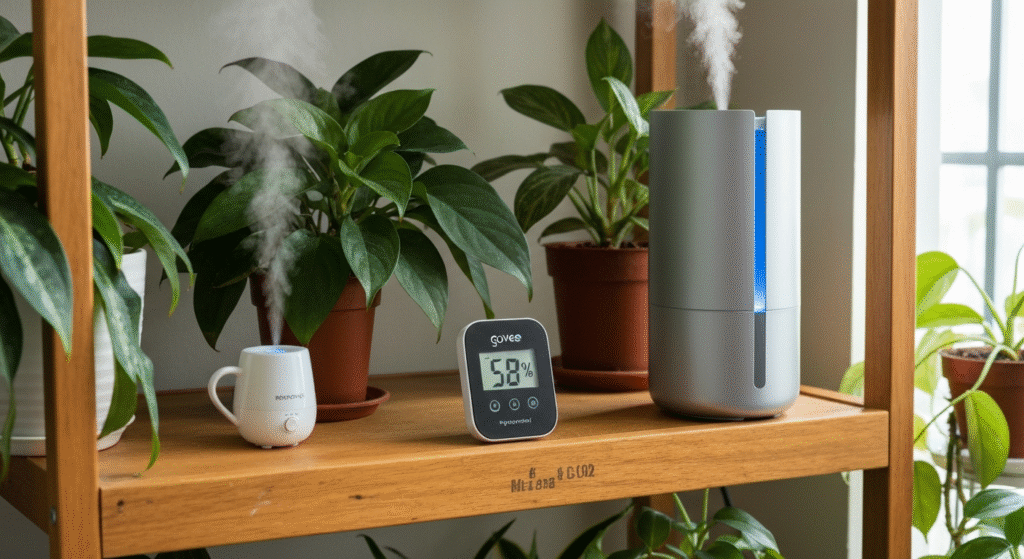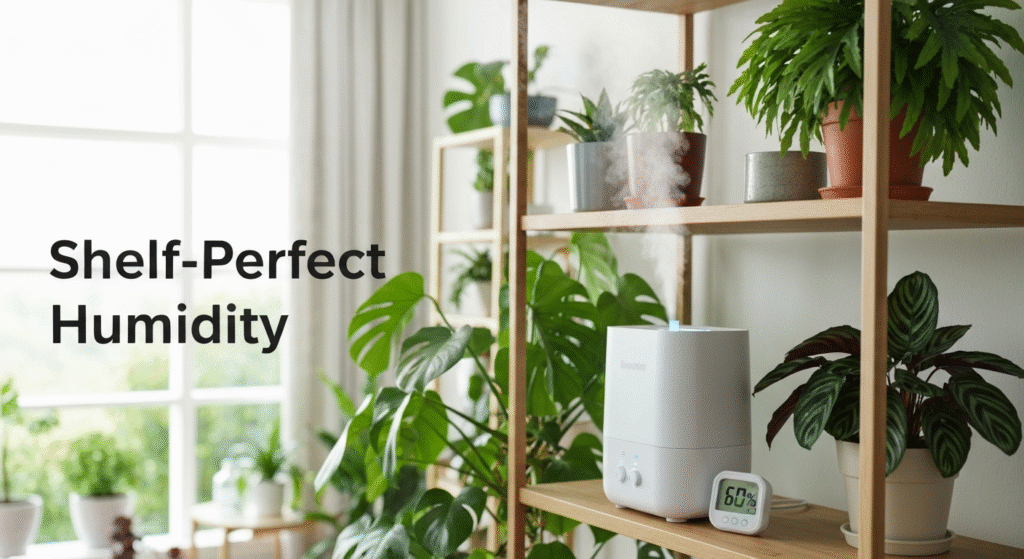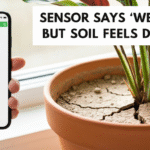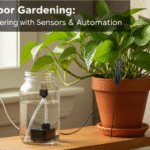That beautiful, multi-tiered plant shelf. You know the one. It looks amazing on Instagram, packed with calatheas, ferns, and alocasias. But in our dry, centrally-heated homes, that same shelf can quickly become a “crispy leaf” graveyard. The biggest problem I see—and one I struggled with for years—is that a big, powerful humidifier designed for a whole room just doesn’t work for a shelf. The mist goes everywhere except where you need it, and bulky units don’t even fit.
The solution is targeted, space-saving tech. You need a humidifier that is both compact enough to live on the shelf and smart enough not to turn your particleboard into a soggy mess. Finding this perfect little gadget can be the difference between a thriving indoor jungle and a constant battle. This guide is all about helping you find it.
Hi, I’m Priya. My journey into smart indoor gardening started about five years ago when I tried to turn my city apartment into a green oasis and, frankly, failed at first. My prized tropical plants kept getting brown, crispy edges. I realized my passion for tech could probably solve my gardening problem. I’ve spent the last few years obsessively testing smart sensors, lights, and (especially) compact humidifiers to finally get my plant shelves to thrive. I’m here to share what I’ve learned, so you can skip the frustration and get straight to the good part.
Why Your Plant Shelf is a “Microclimate” Problem

Before you can fix the problem, you have to understand it. Your plant shelf isn’t just a piece of furniture; it’s a unique microclimate, and it’s often a difficult one for plants.
Here’s the thing: shelves, especially cube-style ones like the famous IKEA Kallax, have very poor air circulation. The air gets trapped. Furthermore, that big humidifier you have sitting on the floor? The humidity from it, which is just water vapor, tends to stay low. It doesn’t effectively travel up three or four tiers to reach your top-shelf plants.
I learned this the hard way. I had a large, 2-gallon humidifier running 24/7 in my living room. The hygrometer (a device that measures humidity) on my coffee table read a perfect 60%. But a small, cheap sensor I placed on my top plant shelf still read a depressing 35%. My plants were just as dry as before.
This is why you need “spot humidification.” The goal isn’t to humidify your entire home. The goal is to deliver a consistent, controlled cloud of moisture to the 10-square-foot area of your plant shelf.
“Smart” vs. “Dumb”: What Really Matters for a Shelf Humidifier?
You’ll see “smart” on every box, but what does it actually mean, and is it worth the extra money? For a plant shelf, my answer is a resounding yes.
- A “Dumb” Humidifier: This has a simple on/off switch or a manual dial (low/medium/high). It runs continuously until it’s out of water or you turn it off.
- A “Smart” Humidifier: This connects to an app on your phone (usually via WiFi or Bluetooth). Its key feature is a built-in hygrometer and target humidity setting.
For a plant shelf, that target setting is everything. My first shelf humidifier was a cheap, “dumb” model. I’d forget to turn it off before work. I came home one evening to a literal puddle on my shelf, warped wood, and a very unhappy-looking peperomia that was soaked.
With a smart humidifier, I set my target to 60%. The unit mists until its sensor reads 60%, then it shuts itself off. When the air dries out and the sensor drops to 55%, it turns back on. This is a game-changer for two reasons:
- It protects your shelves from over-saturation and water damage.
- It’s incredibly efficient. It only runs when needed, so you’re not refilling the tank constantly.
The 3 Types of Compact Humidifiers (And the Only One I Recommend)
When you’re looking for a compact unit, you’ll mainly run into three types. Based on my testing, only one is the clear winner for a plant shelf.
- Evaporative (The “Bulky” One): This type uses a fan to blow air over a wet wick filter.
- Pros: It’s self-regulating (won’t over-humidify) and doesn’t produce “white dust.”
- Cons: The fans are noisy, the wicks need constant replacing and can get moldy, and—most importantly—I have yet to find one that is “compact.” They are almost always too bulky to fit on a standard 12-inch shelf. I’ve given up on this category for shelves.
- Warm Mist (The “Risky” One): This works by boiling water to create steam.
- Pros: The boiling process kills any bacteria or mold in the water tank.
- Cons: It uses more electricity, and the hot steam is a real danger to your plants. I tested one and the steam jet slightly scorched a new leaf on my Calathea Orbifolia that was too close. I’d avoid these for tight shelf spaces.
- Ultrasonic (The “Just Right” One): This is the one you want. It uses a small, vibrating ceramic disk to “agitate” water into a fine, cool mist.
- Pros: They are whisper-quiet, very energy-efficient, and can be made incredibly small.
- Cons: It has one potential downside, which I’ll cover next. But for our purpose, this is the winning technology.
The “White Dust” Problem (And My Simple Solution)
If you’ve ever used an ultrasonic humidifier, you might have seen it: a fine, white film that settles on all your dark-colored furniture and leaves.
This isn’t dirt; it’s minerals. Ultrasonic humidifiers turn everything in the water into mist, including calcium and magnesium from your tap water. When the water evaporates, those minerals are left behind.
My tap water is very hard. After just three days with my first ultrasonic, my black shelves and the dark green leaves of my monstera looked like they’d been dusted with flour. It’s ugly, and it can clog the “pores” (stomata) on your plant’s leaves.
The solution is simple: Stop using tap water.
You must use water with no minerals in it. This means distilled water or reverse osmosis (RO) water. I buy a few 1-gallon jugs of distilled water from the grocery store every other week. It’s a small added cost, but it completely eliminates the white dust problem. My shelves are clean, my plants are happy, and the humidifier’s internal parts stay pristine.
What to Look For: My 5-Point Checklist for a Shelf-Safe Smart Humidifier
After buying and returning several duds, I’ve developed a strict checklist. I won’t even consider a unit unless it meets these criteria.
- Small Footprint & Tall Tank: The base must be small, ideally under 7-8 inches in diameter, to fit alongside your pots. I’ve found that tall, narrow models are much better than wide, squat ones. They have the same water capacity but take up less valuable shelf space.
- A Top-Fill Tank (This is Critical): Trust me on this. Do not buy a bottom-fill humidifier. This is the kind where you have to lift the tank, carry it to the sink, flip it upside down to unscrew a cap, fill it, and then try to flip it back over without spilling. Trying to do this on a crowded plant shelf is a recipe for disaster. I’ve spilled water on my power strips and books more times than I care to admit. A top-fill humidifier means you just lift a lid and pour water in from a small watering can. It’s a non-negotiable for me.
- A Good, Simple Smart App: The app is the whole point. Does it connect easily? Does it have a simple slider to set your target humidity? Can you create a schedule? Look for WiFi-enabled models (like Govee or Levoit) over Bluetooth, as WiFi lets you check on your plants from anywhere.
- Quiet Operation: This is less of a problem with ultrasonics, but check the decibel (dBA) rating. Anything under 30 dBA is considered whisper-quiet. My shelves are in my living room, and a constant fan hum or loud “glug-glug” sound is incredibly distracting.
- Auto-Shutoff & Empty Tank Alerts: A good smart model will not only shut off when the humidity target is reached but will also shut off and send you a phone alert when the tank is empty. This prevents the motor from running dry and burning itself out.
My “Living Room Lab”: What I’ve Learned from Testing

Okay, “lab” is a strong word for my living room, but I have tested several units over the past few years. Instead of recommending specific models that might be discontinued, here are the three categories of compact humidifiers I’ve tested and what they’re good for.
1. The “Micro-Shelf” Specialist (Under 1-Liter)
These are often USB-powered and look like small, decorative cups.
- My Experience: I bought one of these for my IKEA Milsbo cabinet. For a small, enclosed glass cabinet, it’s perfect. It raises the humidity inside from 40% to 70% in about an hour. However, on an open shelf, it’s just too wimpy. The mist dissipates immediately.
- Verdict: Great for a terrarium or glass cabinet. Not powerful enough for an open shelf.
2. The “Aesthetic” Pick (Wood-Grain Diffusers)
These are the small, 300-500ml units that double as essential oil diffusers.
- My Experience: I tried one because it looked nice. The “smart” feature was just a basic timer (1-hour, 3-hour). The tank was so small I had to refill it three times a day. It was a hassle, and the output was minimal. (Also, never put essential oils in a humidifier near your plants. Many oils are toxic to them.)
- Verdict: Looks pretty, but it’s not a serious tool. It’s a toy.
3. The “Workhorse” (2-3 Liter Smart Humidifier)
This is the sweet spot. These units are tall and narrow, hold about 2-3 liters, and have full WiFi app control.
- My Experience: This is what I use on my main shelves. A 2.5-liter tank lasts about 24-36 hours on my smart schedule. The app is a full-featured one where I can set target humidity, link it to other sensors, and set on/off schedules. It’s the perfect balance of compact size and real performance.
- Verdict: This is the one you want. Look for a top-fill, 2-3L, WiFi-enabled ultrasonic model.
My Shelf Humidifier Priorities
Here’s a quick table of what I look for, based on all my trial and error. Your needs might be a little different, but I’ve found this is a good guide.
| Feature | My Priority | Why It Matters to Me |
| Top-Fill Tank | Critical | I’m done spilling water. This is a non-negotiable for easy refills on a crowded shelf. |
| Smart App (Target Humidity) | Critical | This is the key. It protects my wooden shelves and keeps humidity stable without me. |
| Footprint (Size) | High | It has to physically fit. Tall and narrow is the best shape. |
| Tank Capacity | Medium | A 2-3L tank is the sweet spot. It runs for at least a full day. Anything smaller is annoying. |
| Noise Level | Medium | I prefer it to be silent. Most good ultrasonics are. |
| Aesthetics | Low | I’d rather it work well and be ugly than be beautiful and useless. A simple white design is fine. |
How I Set Up My Smart Humidifier for Perfect Plant Shelves
Getting the humidifier is step one. But how you use it is step two, and it’s just as important. Here is my exact, field-tested setup.
Step 1: Protect Your Shelf
First, I never place the humidifier directly on my wooden shelf. Even the best ones can drip a little during a refill. I use a small acrylic tray (you can also use a large, clear plastic plant saucer) to sit the unit on. This catches any spills and protects the wood.
Step 2: Get a Separate, Second Sensor (My Best Tip)
This is the most important advice I can give you. Do not trust the humidifier’s built-in sensor.
That sensor is located right on the unit where the mist is thickest. It’s like standing in a fog bank and trying to guess the weather a mile away. My humidifier will often read 65% (and shut off) while the other end of my shelf is still at 45%.
The Fix: I bought a separate, tiny smart hygrometer (Govee makes great, cheap ones).
- I place the humidifier at one end of the shelf.
- I place the separate sensor at the other end, near my most sensitive plants.
This separate sensor is my “source of truth.” It tells me what the humidity actually is where my plants live. A better understanding of humidity and houseplants and their specific needs will help you see why this monitoring is so crucial.
Step 3: Calibrate Your Settings
Now I use my “truth” sensor to trick my humidifier.
My goal is 60% at the far end of the shelf. I look at my separate sensor. If it says 50%, I go into the humidifier’s app and set its target humidity to 70%. The humidifier will work hard to get its own sensor to 70%, and in the process, it will raise the other end of the shelf to my real target of 60%. It takes a day or two of tweaking, but once it’s set, you’re golden.
Step 4: Add Airflow
My final secret weapon: a tiny, silent USB fan. Humidity without airflow is a recipe for mold, mildew, and fungal problems. I added a small 4-inch fan to each shelf, set on low, just to keep the air moving gently. This combination—consistent humidity from the smart humidifier and gentle air circulation—is the true secret to making tropical plants thrive indoors.
Common Mistakes I’ve Made (So You Don’t Have To)
- Letting the Water Sit: Stagnant water is a breeding ground for bacteria and pink algae. I empty and rinse my tanks with a little vinegar and water at least once a week. A clean humidifier is a healthy humidifier.
- Pointing the Mist At a Plant: It’s tempting, but don’t. Constant, direct mist on leaves can encourage fungal spots. Point the mist nozzle up and out into the open air above the plants.
- Ignoring Empty Tank Alerts: Running an ultrasonic humidifier dry can burn out the vibrating plate. Most smart apps will alert you. Listen to them and refill promptly.
- Using Tap Water: I’m saying it again because it’s that important. I was lazy for a month and it took me an hour to scrub the white mineral scale off my shelves and plants. Just use distilled water.
Frequently Asked Questions
Can I just use an essential oil diffuser as a humidifier?
No. A diffuser is designed to aerosolize oil with a tiny puff of water, not to raise a room’s humidity. Its water tank is tiny and its output is minimal. It’s the wrong tool for the job.
How close should the humidifier be to my plants?
On a shelf, it will be close by default. I keep mine at least 6-12 inches away from the nearest plant. The key is to make sure the mist is going up into the air, not directly onto a leaf.
How often do I really need to clean it?
Once a week. Seriously. I do a quick rinse-and-swish with white vinegar every Sunday when I do my watering. It takes 60 seconds and prevents all the slimy buildup.
Will a humidifier damage my wooden plant shelves?
It can, if you’re not careful. This is why a “dumb” humidifier is so risky. A “smart” humidifier with a target humidity and a separate sensor is the best way to prevent this. It gives the plants the moisture they need without ever letting the air become “wet” or “soggy,” which is what warps wood.
Wrapping It Up
You can have that lush, green plant shelf, even in a small, dry apartment. The key is to stop thinking about your whole room and start focusing on the microclimate of the shelf itself.
A compact, top-fill, ultrasonic smart humidifier is, in my experience, the single best tech investment you can make for your indoor garden. Start with one. Get that all-important separate sensor. Spend a little time tweaking the settings. The goal isn’t just to add more tech to your life; it’s to create a stable, healthy, and thriving environment your plants will absolutely love.


